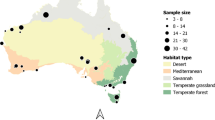Abstract
The demographic performance of avian predators is influenced by climate variations. The Plant Area Index (PAI) is considered a key descriptor of the (evolving) vegetation sensitive to climate and soil aridity and drought stress. To assess if the increased aridity regime in the mediterranean region affects the reproduction of a forest predator, the breeding success of the Tawny Owl Strix aluco was studied over 7 years (1997–2003) in Castelporziano, central Italy. The inter-annual fluctuations in owl demographic output observed in neighbor forest and agricultural sites were compared with climatic variables (rainfall, minimum and maximum air temperature, aridity index) and changes in the PAI estimated by satellite imagery. Out of 326 breeding attempts, the percentage of successful pairs per year ranged between 4 and 28 %, the number of fledglings per successful pair ranged between 1.0 and 1.8 and breeding rate (i.e. the number of fledglings per breeding pair) ranged between 0.1 and 0.4. Demographic, climatic and remotely sensed indexes showed coherent variations among years. Rainfall and lower aridity index are associated with a higher breeding success. The relationship between PAI and breeding rate was found significant only in forest sites. Results suggest that Tawny Owls may positively respond to drier weather conditions by reducing the breeding rate.



Similar content being viewed by others
References
Aviles JM, Sanchez JM, Sanchez A (2000) Breeding biology of the Eurasian Kestrel in the steppes of south western Spain. J. Raptor Res 34:45–48
Blasi C, Carranza ML, Filesi L, Tilia A, Acosta A (1999) Relation between climate and vegetation along a mediterranean-temperate boundary in central Italy. Global Ecol Biogeograph 8:17–27
Galeotti P (1994) Patterns of territory size and defence level in rural and urban Tawny Owl (Strix aluco) populations. J Zool 234:641–658
Gil-Delgado JA, Verdejo J, Barba E (1995) Nestling diet and fledgling production of Eurasian Kestrels Falco tinnunculus in eastern Spain. J Raptor Res 29:240–244
Grignetti A, Salvatori R, Casacchia R, Manes F (1997) Mediterranean vegetation analysis by multi-temporal satellite sensor data. Int J Remote Sens 18:1307–1318
Hirons G (1985) The effects of territorial behaviour on the stability and dispersion of Tawny Owl (Strix aluco) populations. J Zool 1:21–48
Incerti G, Feoli E, Giovacchini A, Salvati L, Brunetti A (2007) Drought estimation through a neural network approach. Int J Biometeorol 51:253–263
Manes F, Giannini M, Giannini MA, Anselmi S (2001a) Biomonitoraggio a differente scala dello stress idrico e dell’ozono troposferico nella tenuta presidenziale di Castelporziano. Accademia Nazionale delle Scienze detta dei Quaranta, Scritti e Documenti 26:365–375
Manes F, Giannini M, Anselmi S, Melini S, Allegrini A (2001b) Studio multitemporale dell’indice di area vegetale (PAI) nella tenuta presidenziale di Castelporziano. Accademia Nazionale delle Scienze detta dei Quaranta, Scritti e Documenti 26:749–764
Moretti R, Mecella G, Moretti V (2006) Caratteristiche climatiche della Tenuta Presidenziale di Castelporziano. In: scarascia mugnozza g.t. (ed), Il sistema ambientale della Tenuta Presidenziale di Castelporziano. Segretariato Generale della Presidenza della Repubblica, II serie Accademia Nazionale delle Scienze detta dei Quaranta, Scritti e documenti XXXVII, pp 26–3)
Paradis E, Guédon G (1993) Demography of a Mediterranean microtine: the Mediterranean pine vole, Microtus duodecimcostatus. Oecologia 95:47–53
Petty SJ, Saurola P (1997) Tawny Owl. In: Hagemeijer EGM, Blair MJ (eds) The EBCC atlas of European breeding birds: their distribution and abundance. T & AD Poyser, London, pp 410–411
Ranazzi L, Manganaro A, Salvati L (2000) The breeding success of Tawny Owls (Strix aluco) in a Mediterranean area: a long-term study in urban Rome. J Raptor Res 34:322–326
Ranazzi L, Salvati L, Fanfani A (2006) Tawny Owl (Strix aluco) density as indicator of wood quality in a Mediterranean landscape. Accademia Nazionale delle Scienze detta dei Quaranta, Scritti e Documenti XXXVII:759–769
Redpath SM (1995) Habitat fragmentation and the individual: Tawny Owls Strix aluco in woodland patches. J Anim Ecol 64:652–661
Salvati L (2001) Does high population density affect reproductive output? Evidence from semicolonial Kestrels Falco tinnunculus. Vogelwelt 122:41–45
Salvati L (2002) Spring weather and breeding success of the Eurasian Kestrel (Falco tinnunculus) in urban Rome. Italy J Raptor Res 36:81–84
Salvati L, Libertà A, Brunetti A (2005) Bio-climatic evaluation of drought severity: a computational approach using dry spells. Biota 5:55–65
Schwartz MD (2003) Phenology: an integrative environmental science. Tasks for vegetation science 39. Kluwer Academic, Amsterdam
Solonen T (2009) Factors affecting reproduction in the Tawny Owl Strix aluco in southern Finland. Ann Zool Fenn 46(4):302–310
Solonen T, af Ursin K (2008) Breeding of Tawny Owls Strix aluco in rural and urban habitats in southern Finland. Bird Study 55(2):216–221
Southern HN (1970) The natural control of a population of Tawny Owls (Strix aluco). J Zool 162:197–285
Sunde P, Markussen BEN (2005) Using counts of begging young to estimate post-fledging survival in Tawny Owls Strix aluco. Bird Study 52(3):343–345
Wendland V (1984) The influence of prey fluctuations on the breeding success of the Tawny Owl Strix aluco. Ibis 126:284–295
Acknowledgments
We are grateful to the ‘Segretariato Generale della Presidenza della Repubblica’, to the Director of Castelporziano Estate, to the ‘Osservatorio Centro Multidisciplinare degli Ecosistemi Costieri Mediterranei’ and to the ‘Commissione Scientifica della Tenuta di Castelporziano’. This research has been supported by grants assigned to A. Fanfani by the ‘Accademia Nazionale delle Scienze, detta dei XL’.
Author information
Authors and Affiliations
Corresponding author
Additional information
This peer-reviewed article is a result of the multidisciplinary project coordinated by the “Academia Nazionale delle Scienze detta dei XL”, Rome, Italy, in the area of the presidential estate of Castelporziano near Rome.
Rights and permissions
About this article
Cite this article
Fanfani, A., Manes, F., Moretti, V. et al. Vegetation, precipitation and demographic response of a woodland predator: Tawny Owl Strix aluco as an indicator of soil aridity in Castelporziano forest. Rend. Fis. Acc. Lincei 26 (Suppl 3), 391–397 (2015). https://doi.org/10.1007/s12210-015-0392-7
Received:
Accepted:
Published:
Issue Date:
DOI: https://doi.org/10.1007/s12210-015-0392-7




